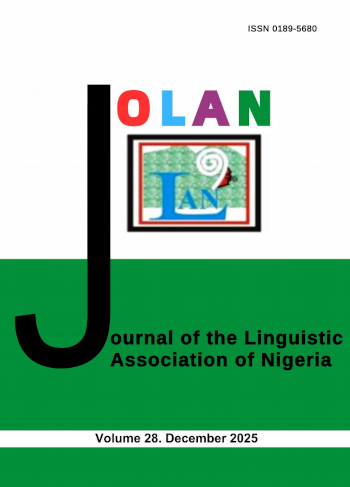Morphosyntactic Analysis of Ibibio Radicals
Abstract
Ibibio is an agglutinating language and words are built up by stringing different morphemes together, often into very lengthy sequences. Some morphemes are meaningful without any attachment (free morphemes) while others (bound morphemes) are glued together with respect to their semantic content. Radicals in Ibibio are mostly bound morphemes which are not capable of occurring alone but require other affixes to come before or after them. Radicals carry the most significant aspects of semantic content and cannot be reduced into smaller constituents. The goal of this paper is to discuss the morpho-syntactic structure of some Ibibio radicals, consider some morphological processes as well as their syntactic configuration in the language. This paper deployed the survey method of research. The data were elicited from five consultants using an audio recorder and also through introspection, given the language competence of the researchers as native speakers. The amassed data were analysed descriptively. Findings show that the major word formation processes employed when combining two radicals or a radical and content word to express a complete thought are compounding, reduplication and affixation. Verbs are also formed by suffixation and nouns by vowel or nasal prefixation while adverbs are formed by reduplication. The reduplication of some radicals does not result in new words but places emphasis, especially where the radical projects an action. It concludes that formation of compound words by combining a radical and a content word generates new concept that makes a meaningful lexical item. Some radicals also create more than one meaning when different affixes are attached to them. This aids in advancing the vocabulary strength of the language as well as give speakers of the language the
opportunity of saying a thing in different ways.
References
Crystal, D. 1990. The Cambridge Encyclopedia of Language. New York, USA: Cambridge University Press.
Essien, O. A. 1990. A Grammar of the Ibibio Language. Ibadan: University press PLC.
Forde, D. and Jones, G. I. 1950. The Ibo and the Ibibio-speaking People of Southern Nigeria. London: International African Institute.
Ndimele 2001. Readings on Language. Port Harcourt: M & J Grand Orbit Communications Ltd
Ndimele, O. 2008. Morphology and Syntax. Port Harcourt: M and J Grand Orbit Communications Ltd and Emhai Press.
Omachonu 2001. ‘Igala Morphological processes’ in Mbah (ed.) Nsukka Journal of Linguistics and African Languages. Nsukka: Department of Linguistics and Nigerian Languages, University of Nigeria.
Oyebade, F. O. 1992. Morphology in Yusuf: (ed.) Introduction to Linguistics. Ilorin: University of Ilorin Press.
Urua, E. E. (2007). Ibibio Phonetics and Phonology. Port Harcourt, Nigeria: M and J Grand Orbit Communications Ltd and Emhai Press.
http://www.cas.unt.edu/~montler/saanich/outline/23.htm Accessed on 20th April, 2017.
https://www.revolvy.com/topic/Root%20(linguistics)&item_type=topic Accessed on 27th March, 2017
https://en.wikipedia.org/wiki/Polysynthetic_language. Accessed on 27th March, 2017.
https://en.wikipedia.org/wiki/Root_ (linguistics). Accessed on 27th March, 2017.














